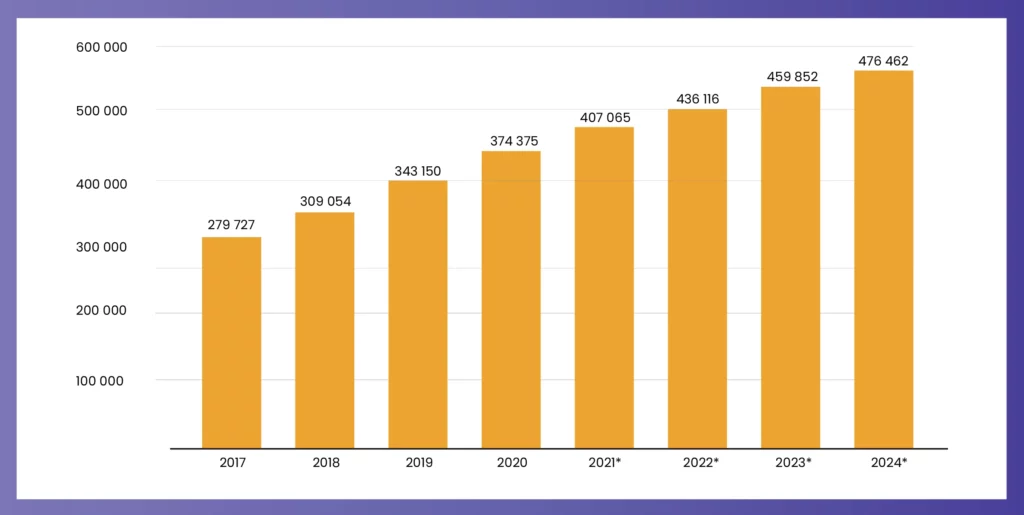How to Build an eCommerce Website to Benefit your Business
An eCommerce website is an excellent and straightforward way to grow and enter the digital market. The benefits are many, including reduced ongoing expenditures, and increased market reach.
The current generation is engaged with the eCommerce world, and it is only expected to increase in size as future generations continue to spend more money. Currently, 43% of consumers research things on social media before making a sale, and by 2024, American eCommerce sales will reach $476 billion.

Building an eCommerce website is easy, even for those without technical understanding. You only require a reliable eCommerce hosting solution, a domain name, and a platform.
Secondly, nowadays, thanks to customizable themes or templates, you don’t have to worry about the development process.
Our blog will walk you through the steps to build an eCommerce website and introduce its benefits for your business.
Why Create an eCommerce Website?
An eCommerce website can bring many benefits for business growth. An online presence in today’s socialized world gives businesses plenty of opportunities to benefit from.
- New market additions
It can be difficult for small businesses to reach customers in new markets. Hence, an eCommerce website benefits you by allowing you to reach new customers that you couldn’t get traditionally.
- Create custom customer experiences
eCommerce websites create a custom shopping experience through videos, stories, and personalized services. You can reach customers via email marketing or social media. These experiences have a way of convincing customers that online shopping offers inclusive opportunities.
- Build your brand Identity
By creating your own eCommerce website, you can ensure that your products are adequately presented, and your customers will remember your brand instead of the marketplace.
How to Build an eCommerce Website Step-by-Step
Building an eCommerce website may seem complex but is actually more straightforward than you imagine. Custom eCommerce solutions are now available, but you must understand them and what your website requires. Or you can consult Tekglide’s developers to help you know what your website needs.
Step 1: Define Business Goals and Plan Your Website
Before exploring the technical aspects, a merchant needs to define business goals and plan the structure of your eCommerce website. By identifying your target audience, you can outline your products or services and establish the foundation of your website. Meanwhile, plan out the user experience you want to provide and the features necessary for your business.
Step 2: Choose an eCommerce Platform and Domain Name
Selecting the right eCommerce platform is an important decision for a merchant. Popular choices include Shopify, WooCommerce (for WordPress users), Magento, and BigCommerce. Each platform has strengths and weaknesses, so we recommend one that aligns with your business model, technical expertise, and budget.
A domain name is like your website’s address that people type into their browsers to visit your website. A good custom domain name represents your eCommerce website brand and helps build trust.
Here are some tips for choosing a good domain name for your online store:
- Keep it short and around 15 characters or less.
- Avoid numbers and hyphens
- Choose .com if possible
- Ensure your chosen domain name doesn’t conflict with other companies or brands
- If you’re having trouble coming up with ideas, a domain name generator can help
Step 3: Choose Hosting Provider
Select a reliable hosting provider to handle your eCommerce website’s traffic and ensure optimal performance. The common hosting types are shared, VPS, cloud, and WordPress. Shared hosting allows a single user server to host many websites, making it affordable and beginner-friendly, ideal for starting users.
VPS hosting uses virtualization technology to divide dedicated private resources from a physical server, offering the most flexibility and root access, suitable for tech-savvy business owners. Meanwhile, cloud hosting divides a physical server into many virtual servers, creating a network for storing site files.
WordPress hosting builds WordPress eCommerce websites, offering optimization features like one-click installation, auto-updates, and a staging tool. Each hosting type caters to different needs and preferences, providing options for eCommerce merchants.
Step 4: Design Your eCommerce Website and Set Up
Your eCommerce website’s design plays a role in attracting and retaining customers. Most eCommerce platforms offer customizable templates, allowing you to create an appealing and user-friendly website. But you must ensure that your website design aligns with your brand, is mobile-responsive, and provides navigation.
Organize your products into categories to simplify navigation for your customers. Include high-quality images, detailed product descriptions, and transparent pricing information. Install search functionality to help customers find products.
Step 5: Set Up a Secure Payment Gateway and Security Measures
To handle online transactions, you would need a secure payment gateway. Reliable options include PayPal, Stripe, Ebizcharge, Apple Pay, Google Pay, After Pay and Klarna. Ensure your payment process is easy and customers feel assured entering their payment details. To make it more secure, install an SSL certificate to encrypt data transmitted between your website and customers. Also, update your website’s software and plugins to patch vulnerabilities and add firewalls and monitoring tools.
Step 6: Set Up Analytics and Monitoring
To determine the effectiveness of your eCommerce website, you can implement analytics tools like Google Analytics. It monitors key metrics such as website traffic, conversion rates, and user behavior, and these insights help you assess your website’s performance. Analyzing this data can help you identify areas that need improvement.
Step 7: Create a Marketing Plan
You can develop a marketing plan to promote your eCommerce website. Use social media, email marketing, and online advertising to reach your target audience. Consider offering promotions or discounts to attract new customers and keep existing ones.
Step 8: Test and Optimize
Optimize your eCommerce website with A/B testing. Test product pages, checkout process, and marketing strategies to identify what resonates with your audience.
Free Consultation with Tekglide’s Expert Developers for Guidance
Book a free consultation with Tekglide’s expert developers and offer specialist guidance tailored to your needs. Our developers bring knowledge and experience, ensuring an understanding of your project requirements. Whether you’re exploring how to build an eCommerce website or website development or seeking custom strategies, our team is dedicated to providing personalized recommendations.
Conclusion
To conclude, building an eCommerce website is a destination that requires careful planning, execution, and ongoing optimization. By following these steps, you can create a powerful online platform that showcases your products effectively and provides a secure shopping experience for your customers. Remember, the key to a growing eCommerce venture lies in continuously refining and adapting your strategies to meet the demands of the digital world.







